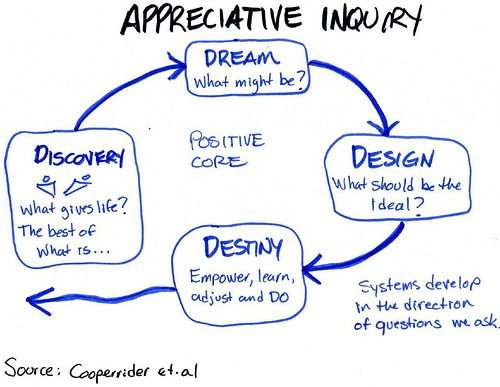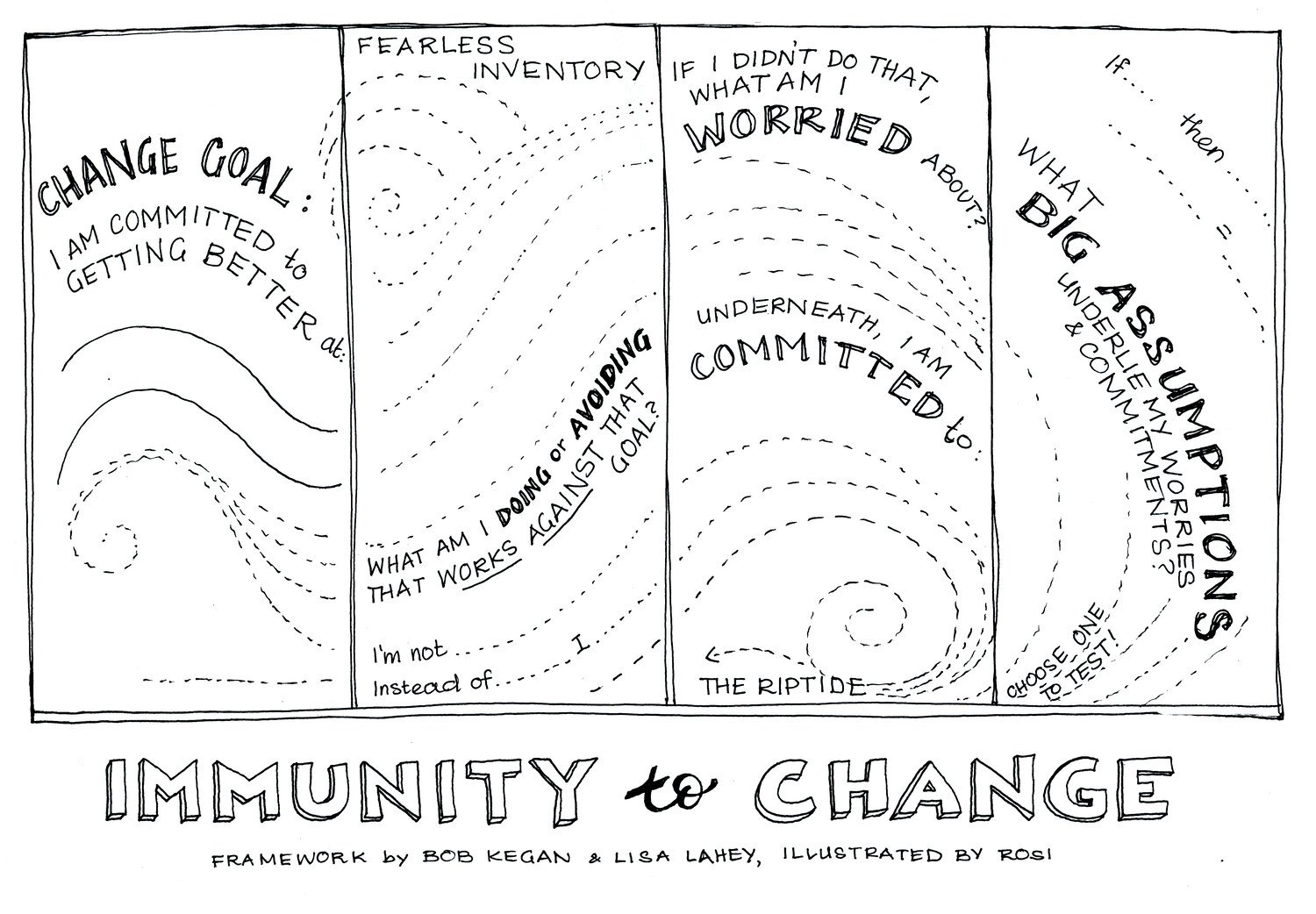You will work a few years with Design in an organisation before you realise a large part of your job is to encourage organisational change.
This observation is something that I share with all of my design students.
They are usually surprised by this at first.
Here are a few of my favorite models that I have used to understand this change.
Appreciative Inquiry — 4D model — David Cooperider
When faced with a situation where we want to make an organisational shift, we typically break the issue apart, identify the root, and focus on that.
With Appreciative Inquiry, you flip this around and instead look at what you appreciate about the organisation — those things already working.
Change is easier since people want to repeat past events they are familiar with and build upon them.
Stories of people and success and build on that.
It makes change less awkward and scary — and they feel more in control.
The process works like this:
Appreciate and value the best of “what is.”
Envisioning “what might be”
Dialoguing “what should be”
Innovating “what will be”
This method works well since what we focus on becomes our reality.
If we focus on what is wrong or what is missing, we see everything through this frame.
Most of my applications of this have been in helping integrate Design capabilities into organisations.
My approach looks sort of like this:
Tell a story where a previous design project went particularly well.
What role did the designer play in the project that made it a success (designer, design team, process etc.)
Based on these success factors, how can we do *more* of these in the future?
Instead of discussing the lack of resources issue, we look at past successes and build on them.
Bridges Transition Model for Change — William Bridges
Anytime a new way of working is introduced, only some are involved in the decision or understand the motivation. This model focuses on the participants and their transition into these new settings. This Model isn’t a change management model as such — it’s only the first part of it. There’s more to change management than getting the buy-in from your employee, but this is a good start.
Bridges’ starts by posing three questions to communicate the change being considered.
What is changing?
What will actually be different because of the change?
Who’s going to lose what?
When I am working to introduce Design (both products and processes) into an organisation, I start with these questions. This is incredibly important to set the foundation for any other change work.
Give this time.
The second part of the model looks at the change transition from the participant's perspective.
Endings- Fear, Denial, Anger, Frustration, Loss, Sadness, Resistance.
At this stage, you should be able to give the participants the proper support.
Understand the Feelings: — Communicate openly and listen empathetically; it’s important to understand their emotions and accept their resistance. Try to understand and respect their emotions or get everyone to talk about them.
Educate them: — Give them some time to accept the change, educate them because people are more likely to resist the change which they don’t understand.
Explain the positive impact: — Explain the positive impact of that change or clarify the benefits of the planned change.
Neutral Zone — Skeptical, Confusion, Resentment, Anxious, Apathetic, Emptiness, Uncertain.
Proper guidance is very important in this stage or during this neutral stage.
Provide proper directions- Often, people may get confused or feel lost because of improper directions. Provide a clear and compelling direction and remind them of their progress.
Discuss- Showing empathy is important in all stages; discuss their feelings or thoughts openly. Take feedback from them and try to have a healthy discussion around this.
Set short-term goals- One of the best ways to encourage participants is to provide them with an achievable short-term goal. This will help develop confidence and motivation.
Remove excess workload:- If possible, try to remove the additional load or work as this reduces the anxiety and workload on them.
New Beginnings — Energetic, Motivated, Enthusiastic, Committed, Renewed, Optimistic, Trust.
How to guide people through stage three-
Don’t get too harsh:- Generally, when participants come to the third stage, the higher authorities may criticise them for small things. Try to maintain a constant emotion, and avoid showing a sudden change in behaviour.
Encourage and Celebrate:- Always encourage the participants to push their limits but be sensitive to their reality. Try to celebrate the results and accomplishments.
Bridges says that people will go through each stage at their own pace since the peoples are psychologically different or have a different mindset.
The people comfortable with the change will quickly move to stage three, while others may not.
Immunity to Change Map — Robert Keegan, Lisa Lahey
Many individuals and teams I talk to have made a solid commitment to change. Despite this, there is always something that stands in the way. The Immunity to Change Map effectively visualises what is preventing this change.
The mapping process demonstrates that even when we have a sincere commitment to move in a new direction, we simultaneously and unconsciously hold competing commitments that lead us to act inconsistently. These two forces contradict one another with the net effect of no change.
“One foot on the gas and the other on the brake”.
The map consists of 4 steps:
State the change or commitment you desire, and prioritise this (1–5 scale).
Ex. “I want to be a better listener during meetings.”What are you doing/not doing that works against achieving this?
Ex. “I am often thinking of a clever response.”What worry about yourself (status, autonomy, fairness etc.) is behind this behaviour? I typically use the SCARF model to help uncover these.
Ex. “I will look stupid, helpless, and lack control.”What assumption am I making that supports this?
Ex. “I assume that if I look, stupid people will not listen”.
For teams, the steps are slightly modified:
The team (or group) collectively decides on an aspirational commitment — a change the group desires to make as a whole.
Ex. “The desire to develop more team trust, the desire to be more effective, and the desire to accomplish a designated task within a period.
Each team member, now separately, reflects over 2, 3, and 4 in the previous section. The following discussion allows team members to share their fears and resistance to making the collective change.
None of these models are magic wands that instantly implement change in an organisation. I typically select aspects of all of them when working with individuals and organisations. The value is to recognise the change that developing Design capabilities entails and focus your efforts on this.
Good luck.




